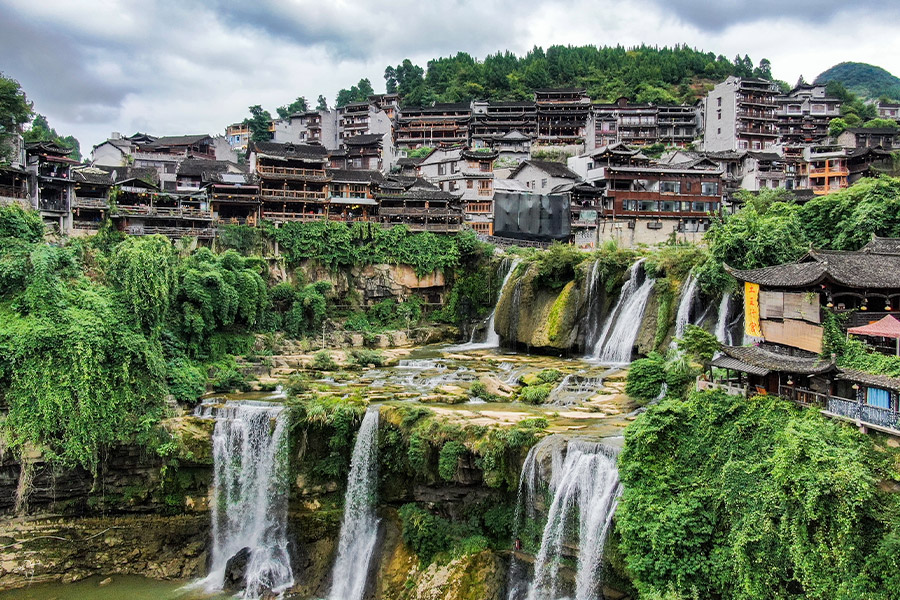Xiangxi Tujia and Miao Minorities Autonomous Region

Xiangxi Tujia and Miao Minorities Autonomous Region in brief
At the edge of Hunan Province and next to Guizhou Province, Hubei Province and Chongqing City, Xiangxi Tujia and Miao Minorities Autonomous Region is known to the world for its Fenghuang County, which is arguably the most picturesque town in China. Covering an area of 15461 square kilometers, it has justification over the Jishou City and other 7 counties. Over 30 ethnic groups reside in this region, with Miao, Tujia, Dong peoples being the most. The region is a mythical wonderland with tourist attractions of Phonix Town, or rather Fenghuang Town, Southern Great Wall, Fu Rong Town (Wang Village), Dehang Village of Miao People, and Red Stone Forest. Located in the Xiangxi Tujia and Miao Minorities Autonomous Region, Fenghuang County covers an area of 1700 square kilometers with a population of 37,000. Most of its population is made up of Miao people and Tujia people. Mapped with green ravines, it is nestled among 47 peaks. Fenghuang presents the world the appearance of an ancient town. It has a main street and amounts of small stone alleys snaking between houses that are built on stilts. The Tuojiang River, the Mother River of Fenghuang County, has incredible beauty with houses casting elegant reflections on the water and boatmen paddling their rafts. Its bustling market lies in the main street with arrays of specilaty shops selling local products such as silverware, handmade items, and batik texitles. But Fenghuang Ancient Town offers far more than natural beauty. With a history of over 300 years, it is crammed with historical sites. The Southern Great Wall in the region was built in Ming Dynasty (1644-1911) for the purpose of defend against the revolt of Miao Ethnic Group. Moreover, Fenghuang is home to a multitude of talents, including generals, leaders, writers, artists and calligraphist. The famous writer Shen Congwen, artist Huang Yongyu, famous politician and educator Xiong Xiling, who portrayed the Phoenix Town in their masterpieces, leads this unsung small town known to China and even the world.
History of Xiangxi Tujia and Miao Minorities Region – A barbarian land
Xiangxi has a long history. According to archaeology discovery, it had been occupied by human being in Old Stone Age. Take the Fenghuang County for example, which was regarded as a ''barbarian'' land in the past. Miao people and Tujia people have been clustered here for generations. But today the minority ethnic people live harmoniously with local Han people. Founded in 1704, it has a history of more than 300 years. The ancient East Gate Tower and North Gate, which were built with red sandstones for military defense and flood-preventing, still stand as hard as rock. The landmark Hongqiao Wind and Rain Bridge is a time-honored bridge worn down inch by inch, seeing the change of the town. Phoenix Town became a county in 1913. In 2001, it was placed on the list of National Historic and Cultural Cities.
Xiangxi Tujia and Miao Minorities Autonomous Region Nowadays – An ever-popular tourist destination
It remained untouched for centuries. But the world is changing; Xiangxi is not immune. The Border Town written by Shen Congwen depicts this town as lovely as poetry, bringing Phoenix Town and Xiangxi Tujia and Miao Autonoumous Region to the public. Tourism powers this region’s phenomenal growth rate. Travelers come here for old village atmosphere, Tuojiang River, Southern Great Wall, or out of admiration for Shen Congwen or Huang Yongyu. Stone lanes, riverside wooden houses, Wanshou Palace, Chaoyang Palaces, Ancestor Hall of Yang Family, residences of Shen Congwen and Xiong Xiling, etc, all these show a distinctive ancient town. The most delightful thing to do in the Phoenix Town is to find a place to soak it all in.
Quick Questions
Our team is waiting for your questions. Please feel free to ask us any questions you might have about our China package tours, Chinese culture, or the sites available. We will gladly help you with any special needs you might have and all questions, like our trip designing is completely free of charge.




